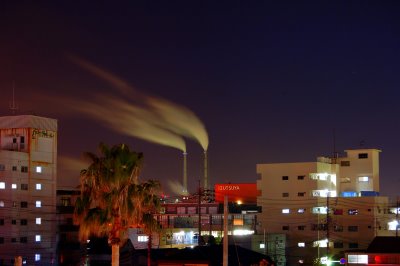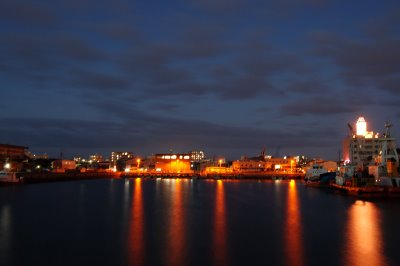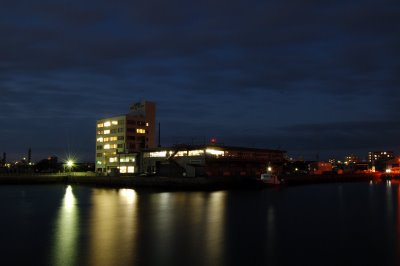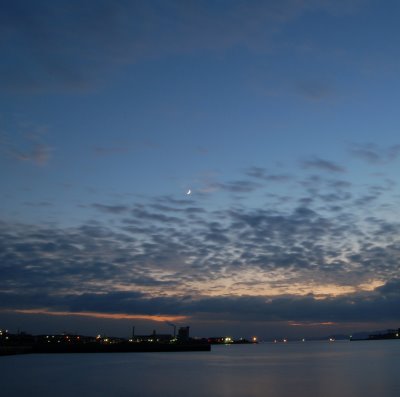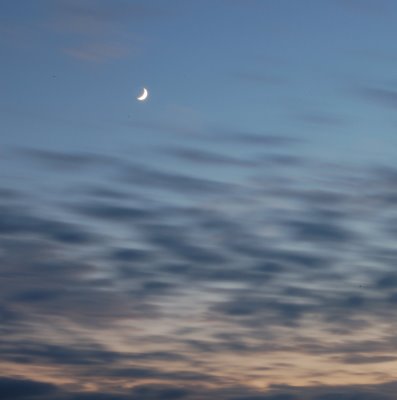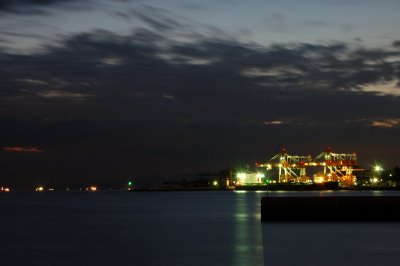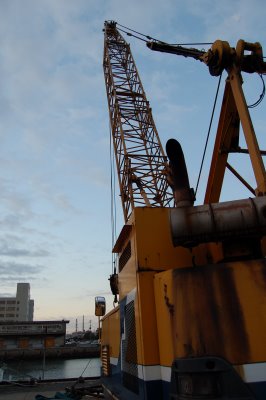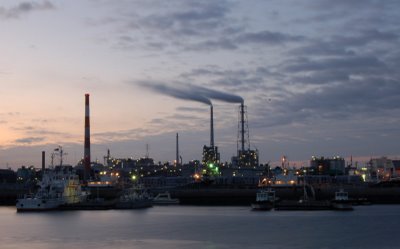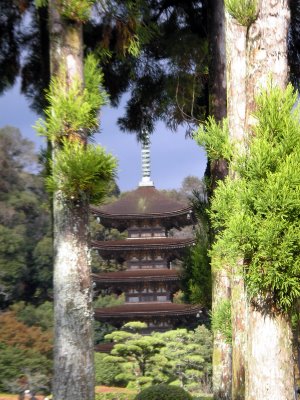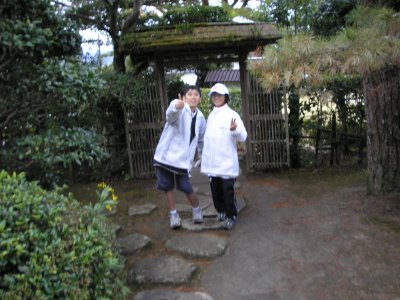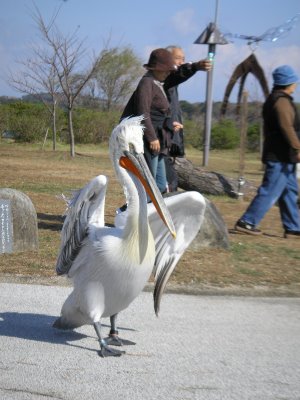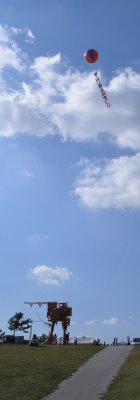As I don't live in a cave, I've been aware that of late restrictions of several natures have been enacted regarding liquids on airplanes. Though this began in England these things have a way of spreading quickly.
Recently I recieved a bottle of Mao (魔王 or "Satan"), a imo (sweet potato) shochu of considerable, if not extreme, rarity and quality. Naturally I brought it with me to Tokyo. It practically had "New Year's written on it. Or at least it would if all the space wasn't taken up with "Prince of Darkness."
To avoid any trouble with airport security on my way to Tokyo I checked my one bag, shochu buried deeply and safely inside.
My friend, Maiko, Hajime and Kimie's younger daughter, was working the counter. We had a short conversation as my bag went through the prescreening for checked baggage.
Security came over with my bag and said something to her.
She turns to me and says, in Japanese, "Um, do you have a bottle in your bag?" I answered yes and we had to dig it out. They gave me a bag for it. I wasn't allowed to check liquids. They made me carry-on my bottle.
Saturday, December 30, 2006
Wednesday, December 27, 2006
Things you find out in airplanes
I'm in Tokyo now. As the plane left Ube it banked to the left. Much more sharply than I'm used to - that the airport faces southwest and the plane must make a one hundred and eighty degree turn. From the relatively oblique angle of the takeoff I had seen some light patches in the water surrounded by buoys. Oyster farms perhaps.
Then the plane banked and I got a clearer view. Acres and acres of seaweed farms. Green sheets the size of boats laid out flat on the ocean's surface. Perhaps I shouldn't have been as surprised as I am, it has to come from somewhere. I guess I always thought it was harvested wild like mushrooms.
I saw more and more of these farms as we flex northwards. None were as stunning as those just off the coast near Kusae station in Ube. Many were neighbors to factories, millions of gallons of mud and, presumably, other unsavory elements washing brown over the green seaweed creating a 1970s living room in the ocean.
The next time I eat makizusi I will be glad to live in Ube.
Then the plane banked and I got a clearer view. Acres and acres of seaweed farms. Green sheets the size of boats laid out flat on the ocean's surface. Perhaps I shouldn't have been as surprised as I am, it has to come from somewhere. I guess I always thought it was harvested wild like mushrooms.
I saw more and more of these farms as we flex northwards. None were as stunning as those just off the coast near Kusae station in Ube. Many were neighbors to factories, millions of gallons of mud and, presumably, other unsavory elements washing brown over the green seaweed creating a 1970s living room in the ocean.
The next time I eat makizusi I will be glad to live in Ube.
Sunday, December 24, 2006
Saturday, December 23, 2006
Thursday, December 21, 2006
Thursday, December 14, 2006
The Port
 I like the city port in Ube. Like most of the city it's designed to be used, not seen. That's why I like it. My favorite things to explore and photograph are factories and dilapidated buildings. We don't have to force beauty on a structure or area for it to have it.
I like the city port in Ube. Like most of the city it's designed to be used, not seen. That's why I like it. My favorite things to explore and photograph are factories and dilapidated buildings. We don't have to force beauty on a structure or area for it to have it.From land, the port is easily accessed on foot, by bike or by car. The spots at the front, closest to the road, belong to the fishermen. On weekdays there is a fish market. The fishermen bring their catches off of the boats and their wives gut the fish, clean the fish and shout the prices of the fish. Farther back is a small crane on caterpillar tracks. It takes the fisherman's boats in and out of drydock.
Farther back still are the civic boats. Fire boats. They sit directly behind a breakwater, easy access both to the inner and outer sections of the port.
That breakwater is the perfect place to take a picture of the sunset. You can see straight out to the west, and watch the sun meet the ocean. On the right are the smokestacks of Kosan called sometimes Ube Industries, supplying the town with employment, tax dollars and its distinctive aroma. Just to the left of the industrial complex is the last barrier of the port, longer than they are tall sit the large cranes, taking containers off of cargo ships. Off in the distance are forested islands. Between industry and nature are the lights of the night fishermen.
Thursday, December 07, 2006
Take me to Mishima
I aborted a semi-planned trip to Tsuwano today because of rain concerns. The concern was, there was rain. The rain didn't stop me from getting up at a quarter of eight though. I charged out of bed, squinted at the computer screen to see if it would rain all day, found out it would and slept until eleven. Perhaps I'll go next week. I hope that I am not too late to catch the fall leaves. If the rain and the cold haven't beaten them down, I'll be lucky.
However, I've picked out another destination for my next unplanned three day weekend. Mishima. It's a small island a hop skip and a jump (read, 50km) off the north coast of Yamaguchi. It's part of Hagi city and takes about an hour by boat to get there. I learned about it from a student the other day. I could discuss the geography, economy, population or the scenery of the island. We'll save that for when I get around to going.
Listening to the student describe the island, what I found most fascinating was its cultural isolation. Mishima people speak a dialect of Japanese that most closely resembles Kyoto Japanese. Many years ago Mishima shared that special relationship with Japan that isolated islands sometimes have with their motherlands. A relationship that England and Australia shared in the past and one that Vashon shares with Washington State today. Mishima was a penal colony. It's my understanding that most of the population, which subsists generally by fishing of general agriculture is the descendants of prisoners from Kyoto shipped over hundreds of years previous.
The island's physical isolation has created a situation where very old traditions can remain, if not intact, at least recontextualized differently than though would have been on the Japanese mainland. This was demonstrated quite interestingly in my student's description of her grandfather's funeral some thirty years previous.
While on the Japanese mainland cremation is the norm, her grandfather was buried. He was dressed in the traditional white kimono and, (as I understand) more traditionally, a white headband with a white cloth triangular ornamentation on the front. The body was then placed, in the fetal position, in a sake cask. The funeral procession wound through the whole town. Everyone dressed in black kimono with banners and sashes embroidered with Chinese characters and dragons. Throughout this whole ceremony his recently widowed wife was not allowed to attend. She was his closest relative and her presence might bring bad spirits or bad luck to visit the ceremony. After the funeral procession made its way back to the family home and the wake commenced. To the best of my students recollection this lasted either three or seven days and nights. Eating, drinking and monks chanting constantly. Then, after the funeral, every week for a period of time a Buddhist priest would visit the home to say prayers and chant.
I apologize for any difference between my transcription of the funerary practices of Mishima and the reality.
I have become enchanted with this isolated and tiny place. I must visit.
Update:
If this guy wants to give better advice on how to run livelier funerals, I invite him to come to Mishima with me.
However, I've picked out another destination for my next unplanned three day weekend. Mishima. It's a small island a hop skip and a jump (read, 50km) off the north coast of Yamaguchi. It's part of Hagi city and takes about an hour by boat to get there. I learned about it from a student the other day. I could discuss the geography, economy, population or the scenery of the island. We'll save that for when I get around to going.
Listening to the student describe the island, what I found most fascinating was its cultural isolation. Mishima people speak a dialect of Japanese that most closely resembles Kyoto Japanese. Many years ago Mishima shared that special relationship with Japan that isolated islands sometimes have with their motherlands. A relationship that England and Australia shared in the past and one that Vashon shares with Washington State today. Mishima was a penal colony. It's my understanding that most of the population, which subsists generally by fishing of general agriculture is the descendants of prisoners from Kyoto shipped over hundreds of years previous.
The island's physical isolation has created a situation where very old traditions can remain, if not intact, at least recontextualized differently than though would have been on the Japanese mainland. This was demonstrated quite interestingly in my student's description of her grandfather's funeral some thirty years previous.
While on the Japanese mainland cremation is the norm, her grandfather was buried. He was dressed in the traditional white kimono and, (as I understand) more traditionally, a white headband with a white cloth triangular ornamentation on the front. The body was then placed, in the fetal position, in a sake cask. The funeral procession wound through the whole town. Everyone dressed in black kimono with banners and sashes embroidered with Chinese characters and dragons. Throughout this whole ceremony his recently widowed wife was not allowed to attend. She was his closest relative and her presence might bring bad spirits or bad luck to visit the ceremony. After the funeral procession made its way back to the family home and the wake commenced. To the best of my students recollection this lasted either three or seven days and nights. Eating, drinking and monks chanting constantly. Then, after the funeral, every week for a period of time a Buddhist priest would visit the home to say prayers and chant.
I apologize for any difference between my transcription of the funerary practices of Mishima and the reality.
I have become enchanted with this isolated and tiny place. I must visit.
Update:
If this guy wants to give better advice on how to run livelier funerals, I invite him to come to Mishima with me.
(The) Internet
I look back at those early days with some nostalgia. Of course, I hopped on after the all text days. I remember about eleven years ago sitting around the kitchen table with my parents looking at the disks we got in the mail, trying to decide whether to go with AOL 1.0, CompuServe or Sierra for our internet provider. I voted for Sierra, 'cause it had pretty colors. But we went with AOL.
Also, thanks to Canadian TV for teaching us that internet uses no definite article.
Monday, December 04, 2006
Obviously it has no connection to anything whatsoever
Normally I don't put shit into reading anything in dreams, honestly, but I had this dream the other night, right? I found myself out in a friends garden painting a picture. It was goin' alright. Painty, painty, painty. Looked pretty good to. I took the easel apart to adjust it, or maybe to see how it worked, I dunno, I mean it was a pretty cool design, kinda like a Czech Hedgehog. Thing is, when I was ready to set the easel back up again, it was very difficult, almost like a puzzle. What made it worse was my friend had this gigantic dog, named Nova, who kept running over and pushing me down and interfering with getting the easel back up so I could start painting again.
Armchair analysis anyone?
Armchair analysis anyone?
My father came to Japan about a week ago
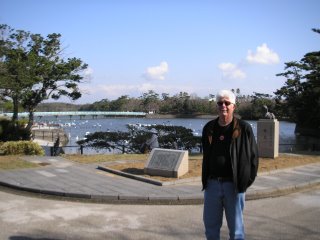 And it was awesome. It was a vacation I sorely
And it was awesome. It was a vacation I sorelyHe'd been planning the trip for some time and I had packed the week with friends to meet and things to do. However, things got off to a little bit of a rocky start with some time zone trouble. Also, I didn't read his itinerary closely enough. So Wednesday (the 8th!) found me growing increasingly nervous as I waited for his plane to arrive. "Goddamit, where is he? The plane got here an hour ago." Got a day to relax in Osaka and see Dan and Ed. The plane came in f'reals on Thursday after which father went promptly to bed.
With morning came breakfast at the hotel followed by a zip through Namba. Bic Camera is fucking awesome. I honestly don't know why they're aren't nine story electronics stores in America. Seriously. Shopping accomplished, we hopped on the shinkansen and mad our way to Ube, to start the trip proper.
I had to show my father who I associated with. I introduced my father to all of my friends here, or at least my close friends. The Itous, who run my favorite sushi shop and have essentially adopted me, Kiyoka and Hiroki, Tomohiro, who owns a favorite bar of mine and lives in my building, Daisuke, and of course the whole gamut of my coworkers.
I had to show my father where I lived. We went to Tokiwa Park. We went to Nagato. We went to Fuji Grand. We went to Hagi. And, of course we went to Rurikoji. There we had some of the best guides ever. Two fifth graders from the elementary school in the neighborhood. They were part of a volunteer brigade and the "troop leader," as I suppose the term would be, followed us around. Every time he tried to help, one of the guides would shush him and say something along the lines of "I'm doing it!"
I had to show my father what I eat. Soba on a rooftile, sushi, tempura, soba in a basket, sashimi, tempura, nikuman and fish jerky. Hopefully he thinks I eat that well all the time.
I saw him off at the airport on the 15th. But any sadness at his departure wore off on the trip home. It took me six and a half hours from airport to front door. I won't bother you with the details save to say my transfer to the Ube line took an hour and a quarter.
I will say though, I hadn't really felt homesick until he came.
Friday, December 01, 2006
Subscribe to:
Posts (Atom)

































